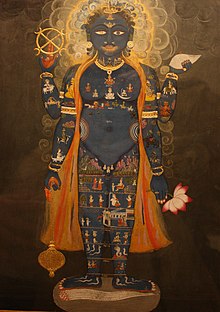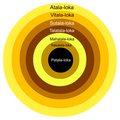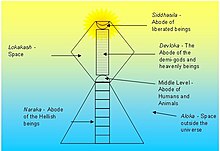Loka
This article needs additional citations for verification. (May 2008) |
Loka (Sanskrit: लोक) is a concept in Indian religions, that means plane or realm of existence.
Buddhism[]
Six lokas[]
In the Tibetan and Tantric schools, "Six Lokas" refers to a Bönpo and Nyingmapa spiritual practice or discipline that works with chakras and the six dimensions or classes of beings in the Bhavachakra. In Buddhist cosmology Kama-Loka, Rupa-Loka, Arupa-Loka has interpreted.[1][clarification needed]
Three lokas[]
There is a cosmological view in Buddhism called Trailokya.[2]In early Buddhism, based upon the Pali Canon and related Agamas, there are three distinct realms:- First the Kama Loka, or the world of sensuality, in which humans, animals, and some devas reside, the second is Rupadhatu Loka, or the world of material existence, in which certain beings mastering specific meditative attainments reside, and the third is Arupadhatu Loka, or the immaterial, formless world, in which formless spirits reside. Arahants, who have attained the highest goal of Nirvana have unbound themselves from individual existence in any form, in any realm, and cannot be found here, there, or in between, i.e., they are found in no loka whatsoever.
Hinduism[]
Three lokas[]

The most common[3] arrangement of lokas in Hinduism are into three parts.
The scholar Deborah Soifer describes the development of the concept of lokas as follows:
The concept of a loka or lokas develops in the Vedic literature. Influenced by the special connotations that a word for space might have for a nomadic people, loka in the Veda did not simply mean place or world, but had a positive valuation: it was a place or position of religious or psychological interest with a special value of function of its own.
Hence, inherent in the 'loka' concept in the earliest literature was a double aspect; that is, coexistent with spatiality was a religious or soteriological meaning, which could exist independent of a spatial notion, an 'immaterial' significance. The most common cosmological conception of lokas in the Veda was that of the trailokya or triple world: three worlds consisting of earth, atmosphere or sky, and heaven, making up the universe."[4]
Fourteen lokas[]
In the Puranas and in the Atharvaveda, there are 14 worlds, seven higher ones (Vyahrtis) and seven lower ones (Pātālas), viz. bhu, bhuvas, svar, mahas, janas, tapas, and satya above and atala, vitala, sutala, rasātala, talātala, mahātala, pātāla and naraka at the bottom.[5]

Higher seven Lokas

The lower seven Lokas
Lokas:
- Satya-loka (Brahma-loka)
- Tapa-loka
- Jana-loka
- Mahar-loka
- Svar-loka (Svarga-loka)
- Bhuvar-loka
- Bhu-loka
- Atala-loka
- Vitala-loka
- Sutala-loka
- Talatala-loka
- Mahatala-loka
- Rasatala-loka
- Patala-loka
Other[]

Map 2: Intermediate neighbourhood of the Earth according to one Hindu cosmology.

Map 3: Local neighbourhood of the Earth according to one Hindu cosmology.
Jainism[]

In Jain texts, the universe is referred to as loka. Jain cosmology postulates an eternal and ever-existing loka which works on universal natural laws, there being no creator and destroyer deity.[6] According to the Jain cosmology, the universe is divided into three parts:[7]
- Urdhva Loka - the realms of the gods or heavens
- Madhya Loka – the realms of the humans, animals and plants
- Adho Loka – the realms of the hellish beings or the infernal regions
Theosophy[]
The concept of lokas was adopted by Theosophy, and can be found in the writings of Blavatsky and G. de Purucker. One of Blavatsky's three worlds are kamaloka (world of desires), which is like a temporary after-life state or an astral plane, according to the teachings of Blavatsky, Leadbeater, and Steiner.
References[]
- ^ Desired Realms (Rupa Loka, Arupa Loka ,Kama Loka)
- ^ "triloka". Oxford Reference. Retrieved 2021-10-09.
- ^ "Loka" in the Encyclopedia Britannica
- ^ Soiver, Deborah A., The Myths of Narasimha and Vamana: Two Avatars in Cosmological Perspective State University of New York Press (Nov 1991), ISBN 978-0-7914-0799-8 p. 51 [1]
- ^ "What are the functions of each of the 14 lokas?". Quora. Retrieved 2021-10-09.
- ^ Jain cosmology
- ^ Shah, Natubhai (1998). p. 25
- Hindu cosmology
- Buddhist cosmology
- Jain cosmology
- Sanskrit words and phrases





